#11th Battalion
Explore tagged Tumblr posts
Text
This is my memorial to my great uncle, LCpl. William Alexander Wyber M.M., 11th Battalion, Royal Scots (1897-1974). I hope this is of interest to those who want to know more about individual soldiers who fought in WWI and what life was like for veterans who suffered from mental health issues after the war.
#wwi#wwi stories#Royal Scots#Clydebank#11th Battalion#mental health#tw: outdated medical terminology#The Great War#1914-1918#Bangour Village Hospital#County Asylums#Historical treatment of schizophrenia#William Wyber
0 notes
Text
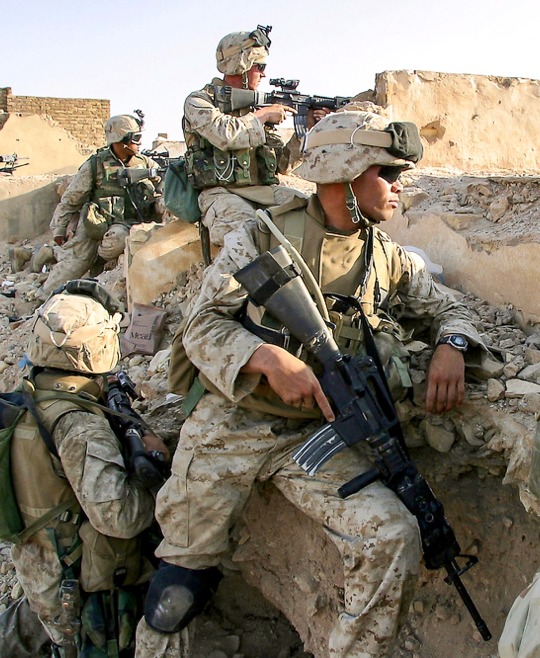
U.S. Marines from 1st Battalion, 4th Marine Regiment, 11th Marine Expeditionary Unit, take up positions behind battle-damaged walls as they continue to engage the fighters of the Montana al-Sadr-led Mehdi Army during the Battle of Najaf in August, 2004.
(Photo by: Lucian Read)
#usmc#us marines#infantry#grunts#najaf#battle of najaf#operation iraqi freedom#military#warrior wednesday
9K notes
·
View notes
Text
beating my head against the walls in Latine
here's eight things that atp will have me immediately closing out of any fic, AleRudy edition:
1.
❌ "the los vaqueros"
ah yes the famed and feared las almas battalion of Mexican special forces. the the cowboys
✅ "los vaqueros"
✅ "the vaqueros"
2.
❌ "the los vaqueros base"
✅ "los vaqueros' base"
✅ "the vaqueros' base"
3.
❌ "corporal alejandro vargas and sergeant rodolfo parra/major rodolfo parra"
look, fuck the military as an institution and also fuck the devs for using American rank structure for members of the Mexican army but
it takes roughly 2 years in the army to advance to Corporal. the equivalent in the Mexican army is Cabo, and Google will not give me the requirements for it no matter how I ask
it takes 3-6 years to advance to Sergeant. From what I can tell, the Mexican equivalent is also Cabo (where Sargento Segundo is closer to Staff Sergeant)
it takes 10-12 years to advance to Major, the equivalent is Mayor (not the English word mayor like of a city, don't be like those white people)
it takes 22-24 years, a bachelor's degree, and officer school to become a Colonel and it takes 18-20 years and a whole mess of leadership courses nearly equivalent to a degree to become a Sergeant Major
put some goddamn respect on their names
✅ Colonel Alejandro Vargas and Sergeant Major Rodolfo Parra
✅ Coronel Alejandro Vargas and Sargento Primero Rodolfo Parra
4.
❌ Fuerza Especiales
❌ Fuerzas Especiale
this is just not understanding Spanish grammar
✅ Fuerzas Especiales ("Special Forces")
❎ Fuerza Especial ("special force")
5.
❌ Sin Nombre ("without name")
Alejandro literally corrects Soap on this one in the game
✅ El Sin Nombre ("The Nameless")
6.
❌ "Alejandro Vargas, leader of Mexican Special Forces"
the leader of Mexican Special Forces is the Secretaría de la Defensa Nacional - the Secretary of Defense - and Fuerzas Especiales is composed of three brigades, 74 independent battalions (like Los Vaqueros), 36 amphibious special operations groups. Colonels command single brigades at most.
Alejandro is capable of leading Mexican Special Forces, but it would require him to retire from the field and get more of a desk job, with far more politics than I think he'd have patience for
✅ "Alejandro Vargas, leader of Los Vaqueros - a battalion of Fuerzas Especiales stationed in Las Almas"
7.
❎ "our ancestors, the Aztecs"
look, indigenous identity is weird sometimes and I don't know enough specifics about the culture around it in Mexico to have a solid opinion, but I'm also very fucking tired of people thinking the only indigenous groups in Mexico are the Nahua (Aztecs) and Maya. if they're on the Texas border and their families have always lived there, their heritage is most likely seven different Apache nations/language groups in a trench coat with some Spanish conquistador on the side. they're most likely not related to any famous indigenous chiefs or other figures, but it's very possible they can trace their Spanish ancestry back directly to nobility
for example, I am related to absolutely none well-known Tsalagi or Kwikipa people as far as I'm aware, but I am a direct descendant of the brother of King Ferdinand the Catholic, which also means I'm a direct descendant of the guy who started the Inquisition (and now I'm Jewish (and pro-Palestine for those who want to know) so take that, colonizer)
also while Bayardo is Mexicano, Alain is Cubano, please be respectful when talking about the actors or when in their instagram lives and just. don't make assumptions y'all
8.
❎ "Los Vaqueros" is a nickname from the people of Las Almas, the battalion's actual name that is on all the paperwork and dog tags is more likely numerical or describing their role/location - like "11th Battalion" or "The Borderline Battalion" or something like that. maybe even both, like "The 11th Border Battalion"
#/incoherent noises/#call of duty#rodolfo parra#alejandro vargas#alerudy#bayardo de murguia#alain mesa#cod mwii#fandom critical#writing tips
549 notes
·
View notes
Text
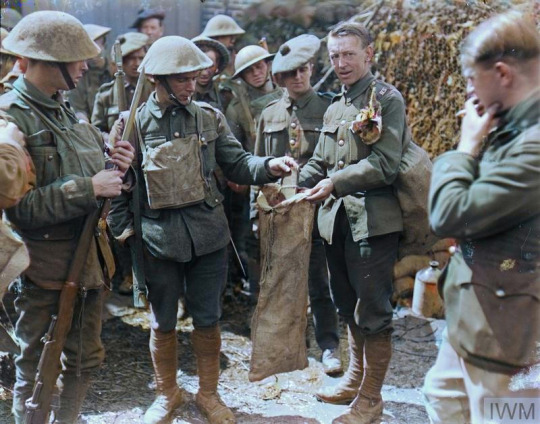
Collecting personal belongings, pay books and identity discs from men of the 11th Battalion, Royal Scots, about to go "over the top", 1918.
#world war one#the great war#world war 1#1917#the first world war#wwi#historical photos#history#canadian history#ww1#ww1 history#ww1 art#ww1 poetry#ww1 fiction#military history#british army
200 notes
·
View notes
Note
Who are Camille's siblings? Do we know their names or anything about them?
In total, Camille’s parents Jean Benoît Nicolas Desmoulins and Marie Madeleine Godard had nine children, four of which died during childhood:
Lucie Simplice Camille Benoît (March 2 1760 — April 5 1794)
Henriette Aimery Angélique (21 February 1761 — 17 June 1770)
Marie Élisabeth Émilie Toussaint (November 1 1762 — December 20 1839)
Stillborn girl, buried at the day of her birth (January 15 1764)
Armand ”Dubocquoi” Jean Louis Domitille (May 5 1765 — 1793)
Anne Clotilde Pélagie Marie (June 20 1767 — ?)
Lazare ”Sémery” Nicolas Norbert Félicité (June 6 1769 — January 1811)
Clement Louis Nicolas (November 23 1770 — April 16 1778)
Charles Maximilien Yves Nicolas Reignier (June 17 1772, probably didn’t reach adult age)
We know Camille was the only one of the siblings that was given a higher education in Paris. Something we might find an explanation for in a letter to him dated January 23 1791 (cited in Hervé Leuwers’ Camille et Lucile Desmoulins: un rêve de république (2018)), where the father places his oldest son on a higher level than the rest of his children:
Your brother Dubocquoi has always had a rather limited peak, he has just acknowledged it to you; but it is not his fault. In the portion of nature and in the lot of the spirit, why have you exercised your birthright so copiously and taken such a great precipitate, to leave your siblings’ afferent share so small?
Camille expressed himself in similar terms in a letter to his father dated October 8 1789. I’m just gonna let this part of this hilarious comic by @theorahsart illustrate the passage:
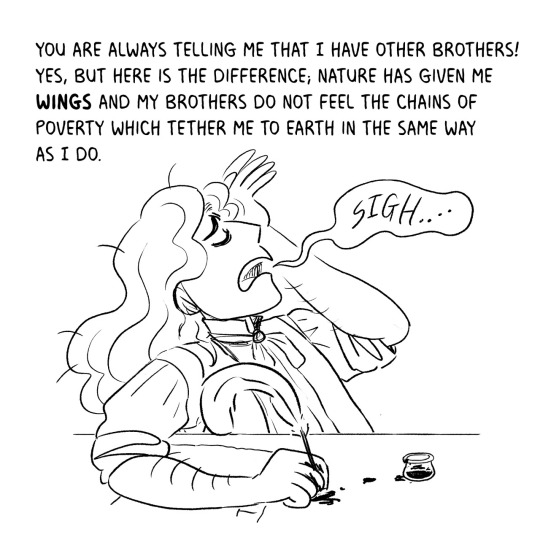
Camille spending the majority of his time away from his family seems to have ended up in him not knowing his siblings all that well, as we in 1792 find a letter where his father has to tell him the name of his brothers as well as their occupations (cited in Camille Desmoulins, a biography (1909) by Violet Methley):
You ask me, my son, for the name of your brother, Du Bucquoy, as well as for that of Semery. The former is called Armand Jean Louis Domitille, who was born on May 5th, 1765. For the past seven years he has served in the late Royal Roussillon cavalry regiment, or the 11th Regiment of the Army of the Midi, and which I believe is either in the interior at Saumur or at Saint-Jean-d'Angely, for I have had no news of him for the last twelve months. The latter is named Lazare Nicolas Norbert Félicité, born on June 6th, 1769, and for the past two years in the loth Battalion of Chasseurs, late Gevaudan, with the Army of the North, in which he shows much zeal. He tells me in his last letter that he is a forlorn sentinel in a wood, and congratulates you on the birth of a son. As for me, I also am married. My wife is a musket, and I take greater care of her than of myself.
On February 8 1793 Lucile has written in her diary: ”C(amille’s) brother came. We had dinner at Madame Brune’s.” In a letter dated July 9 1793 Camille shares more details on his brothers, who by now are both serving in the revolutionary army. These parts got censored when the letter was published for the first time in 1836, and restored in Hervé Leuwers’ biography:
I have received unfortunate news of my brother, who has been lost to drunkenness and expelled from his regiment. I don't know if he wrote to you about his mishap. He has not dared to write to me about it, and he is right in not to. It is most unworthy that I should take an interest in him, and I am really angry that he has taken my name, which he has sullied in the army. Nevertheless, I had advised him to pour water into his wine. I don't know what has become of him since he was forced to resign as an officer. His conduct might have caused you grief under the old regime, but it is a duty that a family of republicans and good men consists of nothing but those who are republicans and good men. […] I am very sorry that Sémery was killed. I would have had no reason to be ashamed of him, and I would have procured for him a speedy promotion of which he proved himself worthy, for things are going well and will be better.
Soon thereafter, Camille does however find out the information regarding his youngest brother’s death is false, whereupon he writes a new letter to his father:
I am very sorry to have written to you that my brother Sémery would have died fighting for his homeland. I had no other certainty of a loss so grievous to you than the indication of his long silence, and I eagerly laid hold of your doubts of his death to fix my hopes upon them. May he be returned to you by the enemies into whose hands he may have fallen captive. I feel even more now, when I see my son, how sensitive this blow must have been to your heart.
Sémery had indeed not died in battle, but been captured at the siege of Maestricht. According to La jeunesse de Camille Desmoulins (1908) he was released after three years. In 1802 he was admitted to the 27th legion of gendarmerie on foot, and was serving in Piémont à la Chiesa as gendarme of the Stura company when he died by an accident in January 1811. The other brother, Dubucquoi, did however die in Vendée in 1793, I’ve not discovered on which date.
As for the two surviving sisters, we seemingly only know that they got married. According to geneanet, the eldest sister Marie Élisabeth Émilie Toussaint married one Théodore Morey in Guise, December 25 1793, while Anne Clotilde Pélagie Marie married Simon Isidore Lemoine in the same town on June 5 1794. Leuwers cites a document showing the two couples were still together by March 4 1797. He adds that both husbands were gendarmes and their wives left Guise to be with them at their posts. Somewhere after 1797 Marie Élisabeth Émilie Toussaint got remarried to one Théodore Lagrange before dying in Paris on December 20 1839, with one Antoine Nicolas Desmoulins as witness. When and where Anne Clotilde Pélagie Marie died I’ve not been able to discover.
#camille desmoulins#desmoulins#frev#ask#camille not knowing his brothers’ names tho… 🫢😆#tho tbf i’m not sure if i know my brothers’ middle names either…
54 notes
·
View notes
Text

Czechoslovak tank crews pose for a photo next to a Valentine Mk.III tank belonging to one of the units of the 11th Czechoslovak Battalion in Tobruk. December 1941 - February 1942
#wwii#siege of tobruk#tanks#valentine#british tanks#british armor#north african campaign#mediterranean theater
29 notes
·
View notes
Text
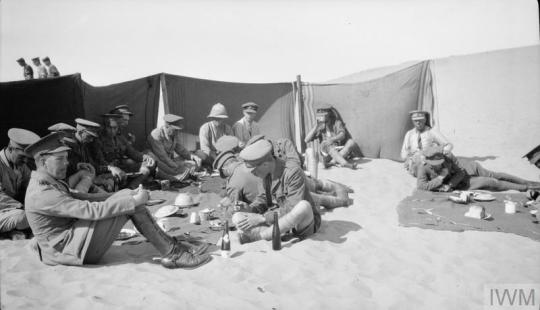
Image: IWM (Q 57819) 1917 The Advance across the Desert: Officers of the 1/11th County of London Battalion London Regiment having a picnic meal with blankets erected as screens against the blowing sand at Romani.
33 notes
·
View notes
Text
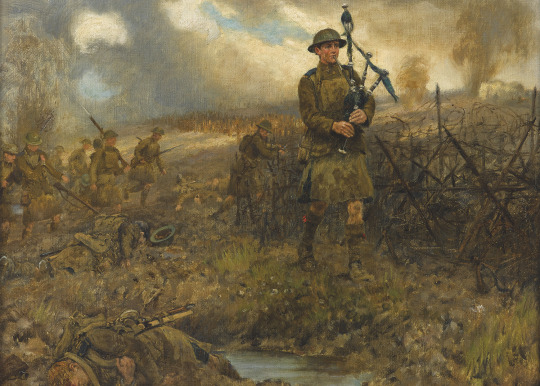

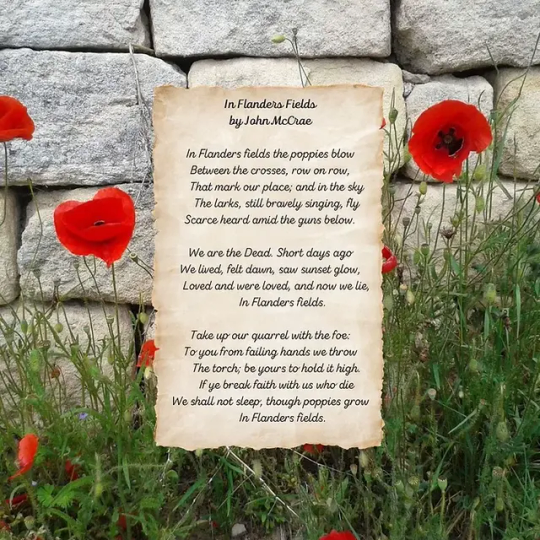


On 11th November 1918 an armistice came into force ending fighting in the First World War.
Hey! Jock, are ye glad ye ‘listed?
O Jock, but ye’re far frae hame!
What d’ye think o’ the fields o’ Flanders?
Jockey lad, are ye glad ye came?
Wet rigs we wrought in the land o’ Lennox,
When Hielan’ hills were smeared wi’ snaw;
Deer we chased through the seepin’ heather,
But the glaur o’ Flanders dings them a’!
This is no’ Fair o’ Balloch,
Sunday claes and a penny reel;
It’s no’ for dancin’ at a bridal
Willie Lawrie’s bagpipes squeal.
Men are to kill in the morn’s mornin’;
Here we’re back to your daddy’s trade;
Naething for’t but to cock the bonnet,
Buckle on graith and kiss the maid.
The Cornal’s yonder deid in tartan,
Sinclair’s sheuched in Neuve Eglise;
Slipped awa wi’ the sodger’s fever,
Kinder than ony auld man’s disease.
Scotland! Scotland! little we’re due ye’,
Poor employ and skim-milk board.
But youth’s a cream that maun be paid for,
We got it reamin’, so here’s the sword!
Come awa’, Jock, and cock your bonnet,
Swing your kilt as best ye can;
Auld Dumbarton’s Drums are dirlin’,
Come awa’, Jock, and kill your man!
Far’s the cry to Leven Water
Where your fore-folks went to war,
They would swap wi’ us to-morrow,
Even in the Flanders glaur!
Neil Munro.
I salute all the lives lost during the war but I cant see why the fighting had to continue after the Armistice had been agreed.....
The armistice was agreed at 5.10am on 11th November to come into effect at 11am. The news was conveyed around Europe within the hour. The original armistice was for a period of 36 days, after which it had to be renewed. This was done four times before the Treaty of Versailles was signed. The only problem is that the war did not completely stop at 11am on 11th November.
The Entente had already agreed armistices with Bulgaria on 29th September, the Ottomans on 30th October, and the Austro-Hungarian Government on 3rd November. Germany was the last of the Central Powers to sue for peace. The Armistice with Germany was agreed to come into effect at 11am to allow time for the news to reach combatants. However, fighting continued in several places during and after that time, including on the Western Front.
General John Pershing, Commander of the American Expeditionary Force, did not approve of the armistice. Consequently he gave no instructions to his commanders to suspend any new offensive action during the remaining hours until 11am. This gave individual commanders latitude to determine their actions in the last few hours and in some quarters there was fierce fighting up to 11am which was difficult to stop.
On 11th November alone there were nearly 11,000 casualties, dead, missing and injured, exceeding those on D-Day in 1944. Over 3,500 of these were American. Pershing had to face a Congressional hearing to explain why there were so many deaths when the hour of the armistice was known in advance, it was totally avoidable, over 11,000 families lost their fathers, their uncles, their sons and their nephews, needlessly.
An armistice is a ceasefire, not an official end to war.
Demobilisation of British, colonial and imperial troops did not finish until 1920, considerably longer than servicemen had anticipated. Although fighting continued elsewhere, the armistice between Germany and the Allies was the first step to ending World War I. The global reaction was one of mixed emotions: relief, celebration, disbelief and a profound sense of loss.
During the First World War 140,000 Scots are killed, among these figures, which vary somewhat, from to 500 to 1000, were the Bagpipers, sent “over the top” to lead the Scottish troops into battle.
Nicknamed Die Damen aus der Hölle (Ladies from Hell) by German soldiers for their distinctive tartan kilts and unparalleled bravery, the pipers from the “Black Watch”—the 3rd Battalion, Royal Regiment of Scotland—garnered a fearsome reputation on the battlefields of World War I.
Standing in full view of German soldiers, often at times armed with only their bagpipes, pipers were the first “over the top”, acting as a clarion call for troops to keep moving. The sound of the bagpipes would spread terror among the German troops—when one “Lady from Hell” fell, miraculously another piper would seemingly arise out of the trenches to take his place...............
By the time the second world war came pipers were not ordered to lead the men into battle, well except on the orders of Simon Fraser, 15th Lord Lovat whose personal piper Bill Millin, commonly known as Piper Bill who, when he questioned Lovat after being told to pipe the the men into battle on the beaches of Normandy was told, Ah, but that's the English War Office. You and I are both Scottish, and that doesn't apply"
Flowers have always held symbolism in many cultures around the world. One such flower is the red poppy, almost synonymous with Remembrance Day, observed in Canada. Poppies have become the flower of Remembrance Day for several reasons, with a significant connection to the famous war poem "In Flanders Fields" by Lieutenant Colonel John McCrae.
The poem "In Flanders Fields" describes the poppies that grewamid the graves of soldiers who died during World War I in Flanders, a region in Belgium. The poem's vivid imagery and poignant verses made poppies a symbol of remembrance for those who had lost their lives in conflict.
Flanders, where many battles of World War I took place, saw extensive destruction and loss of life. Despite the devastation, the red poppies continued to grow in the churned-up soil, a symbol of resilience and renewal. The contrast between the poppies and the war-torn landscape made them a powerful symbol of remembrance.
In 1921, the Royal British Legion adopted the red poppy as a symbol for their annual Poppy Appeal, which raises funds to support veterans and their families. The tradition of wearing a red poppy to remember the fallen and support those in need became more widespread.
The practice of wearing red poppies on Remembrance Day has been adopted by many countries around the world as a way to honor and remember those who have sacrificed their lives in wars and conflicts.
The last pic here is ex-Private H.E. Day of the 15th Hussars who lost a leg during the war selling wooden crosses)
29 notes
·
View notes
Text
Putin is trying to pass off North Korean troops fighting in the Russian army as members of the Buryat ethnic group in Siberia.
It's already suspected that Putin is giving North Korea missile technology in return for ammunition and other military supplies. Apparently troops from North Korea are also part of the deal. Unfortunately for Putin, they seem to be as useless as his own troops.
The Suspiline report citing Ukrainian intelligence sources says that 18 North Korean soldiers fled their positions somewhere on the border between the Bryansk and Kursk regions of Russia, just 7 kilometers (4.4 miles) from the state border with Ukraine. The source said the reason for them absenting themselves is not known but it said Russian forces were currently hunting them while the commanders in the area were trying to cover up the incident and to hide it from higher command. The incident comes just a day after Russian President Vladimir Putin put forward a request to ratify the treaty for a “comprehensive strategic partnership” between the Russian Federation and North Korea, which had been signed on June 19 during Putin’s visit to the DPRK.
Claiming that North Koreans are actually Buryats is quite a stretch. Buryats have a generally East Asian appearance which might fool people in Europe. But once they speak or write, the similarity disappears.
Buryat is related to Mongolian and uses the Cyrillic alphabet. Korean is rather unique and uses its own homegrown phonetic script. They don't sound or look anything alike.
The report of these soldiers being absent without leave (AWOL) also coincided with other intelligence reports that up to 3,000 North Korean combat troops were being trained to form a “special Buryat battalion” at the base of the 11th Separate Air Assault Brigade of the Russian army at Sosnovy Bor near Ulan Ude in Buryatia. The reports say the unit is currently being provided with weapons and equipment. A Ukrainian milblogger, Igor Sushko, said on X / Twitter on Tuesday that the North Korean troops were being issued with Russian military identity cards identifying them as Buryats. The Buryatia Republic is situated in eastern Siberia, where its indigenous people have an Asian appearance. Andrei Kovalenko, head of Ukraine’s Center for Countering Disinformation, commented that integrating North Korean military personnel into Russian forces was likely to be complicated by the language barrier: “Less than 1% of the cadre officers in the North Korean army are proficient in Russian. Understanding this is crucial for examining the potential future involvement of these troops with the Russian armed forces. “Although Russia might utilize North Korean soldiers initially in the Kursk region, there’s a possibility that several tens of thousands could eventually be deployed to Russian-occupied Ukrainian territories alongside Buryat counterparts,” Kovalenko added.
It would be interesting to hear how the Buryats and North Koreans are getting along in Russia. The Buryats have every right to resent that Putin is trying to pass off North Koreans as Buryats.
The attempt to include North Korean troops with the Russian forces in the Ukraine invasion is another indication that Russia is getting short of troops.
New York Magazine recently featured a lengthy interview with Michael Kofman of the Carnegie Institute called Ukraine War: Why Russia is in More Trouble Than It Looks.
A relevant excerpt...
Russia’s advantage has been the ability to withstand very high levels of attrition because of the materiel and manpower resources they have, and also their significant capacity for mobilization of resources on a national scale — that is, defense industrial production, manpower recruitment, and the like. But Russia’s actually operating under very significant constraints. And if anything, its advantage on the battlefield is likely to decline as we get into this winter and look further ahead into 2025. First, in terms of equipment, the Russian military has been sustaining very high levels of loss that are principally being replaced by Soviet-era stocks — not entirely, but at this stage, Russia is eating through its Soviet legacy, and its rate of equipment production is quite low relative to the numbers being lost on the battlefield. This doesn’t mean that Russia is going to run out of armored fighting vehicles. What it does mean is that the Russian military has increasingly been forced to adjust tactics to minimize their losses, and that also reduces their ability to achieve any operationally meaningful breakthroughs. When you look at manpower, the Russian government has significantly increased the payouts and benefits to recruit personnel. The reason for that is straightforward. It’s clear that at this rate of loss, the Russian contract recruitment campaign is unable to keep up. This too does not mean that Russia is going to run out of manpower, but it’s clear that they’re struggling, and they are not likely to be able to sustain this pace of operations, staying on the offensive with this rate of loss.
Russia has apparently already been trying to recruit mercenaries in Syria and possibly even Africa. The quality of foreign troops in Russia has been rather uneven. That 18 North Korean troops have gone AWOL and may be trying to escape to Ukraine is an indication that importing fighters from abroad is not going well for Putin.
#invasion of ukraine#north korea#dprk#north korean troops go awol#russia#vladimir putin#buryats#buryatia#michael kofman#조선민주주의인민공화국#буряад орон#россия#владимир путин#путин хуйло#добей путина#самоволка#россия проигрывает войну#россия - террористическая страна#руки прочь от украины!#геть з україни#вторгнення оркостану в україну#деокупація#слава україні!#героям слава!
24 notes
·
View notes
Text
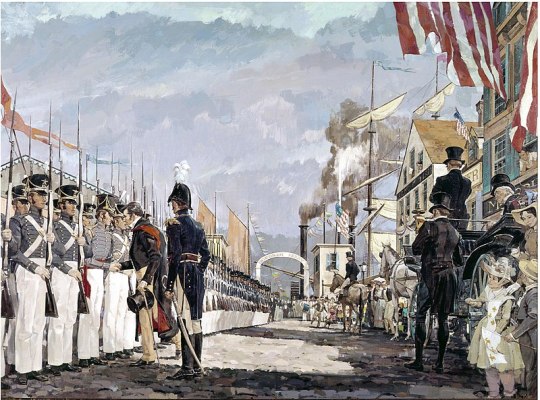
Lafayette greeting the National Guard (2d Battalion, 11th New York Artillery) on July 14, 1825, by Ken Riley
On August 15, 1824, the Marquis de Lafayette arrived in New York to begin a grand tour of America. He toured all 24 states of the Union and received an enthusiastic welcome everywhere he went. One newspaper editor commented on the over-the-top hero worship as follows:
The people are wild with joy, and the gratitude and love of all persons, of every age, sex and condition, seems hardly to be restrained within the bounds of propriety.... At one place they failed so far in self-respect as to contend with horses for the privilege of drawing the revolutionary chief in his carriage! It is to be hoped that the general will not be thus insulted again – for insulted he must be when he sees the sovereigns of this great and glorious country, aiming at the most magnificent destinies, converted into asses or other beasts of burthen. It is his desire to be treated like a man, not as a titled knave or brainless dandy.
The visit cemented Lafayette's fame in America for a new generation. It also left a lasting impact in the place names and monuments found across the United States. For details of the trip, and how it came about, see "Lafayette's Visit to America in 1824-1825."
21 notes
·
View notes
Text
Court Circular | 11th December 2024
St James’s Palace
The Princess Royal, Patron, Shaftesbury, this morning visited Netteswell Rectory, Manston Road, Harlow, and was received by Mr Vincent Thompson (Deputy Lieutenant of Essex).
Her Royal Highness this afternoon visited Brightlingsea Museum, Dove House, Station Road, Brightlingsea, and was received by His Majesty’s Lord-Lieutenant of Essex (Mrs Jennifer Tolhurst).
The Princess Royal, Colonel-in-Chief, Intelligence Corps, later visited 1 Military Intelligence Battalion at Merville Barracks, Colchester, Essex.
Her Royal Highness, President, Racing Welfare, this evening attended a Carol Concert at Tattersalls, Terrace House, 125 High Street, Newmarket, and was received by His Majesty’s Lord-Lieutenant of Suffolk (Clare, Countess of Euston).
The Princess Royal, President, Racing Welfare, afterwards attended a Dinner at the Jockey Club Rooms, 101 High Street, Newmarket, and was received by the Hon Peter Stanley (Deputy Lieutenant of Suffolk).
9 notes
·
View notes
Text
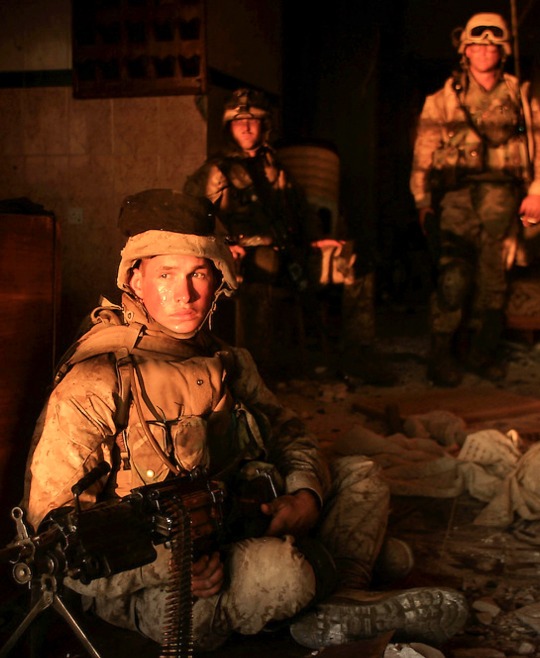
The setting sun shines on a group of U.S. Marines from 1st Battalion, 4th Marine Regiment, 11th Marine Expeditionary Unit, as they keep a watchful eye while taking a break in an abandoned house during the battle of Najaf in August 2004.
Semper Fi to that hard charging Marine for keeping a watchful eye and ready to lay down some hate with his SAW.
(Photo by: Lucian Read)
110 notes
·
View notes
Text
Louis XIII and his cooking adventures 🍴🥞
When it comes to our Louis XIII cult, I often refer to the king's iconic omelettes, but what about his other stuff? For example, he really loved sweets (like beignets or jams), but could he also cook them? The answer is YES, and that's not even all yet!
Louis was a curious child who's head was already filled with various interests and cooking became one of them when he was only ten years old at the time (which is quite unusual for a king). First ever case of the king cooking was recorded on february 11th of 1611, when he was preparing milk soups for the Duchess of Guise / Catherine of Cleves. So milk soup, most likely, could be Louis' very first dish made by himself!
Of course many kids have a sweet tooth and our precious omelette king was not an exception which I guess is why he started to learn how to cook mostly from recipes of sweets. Also, take a shot every time I say "sweets" or "cooking" (don't..) 🕊️
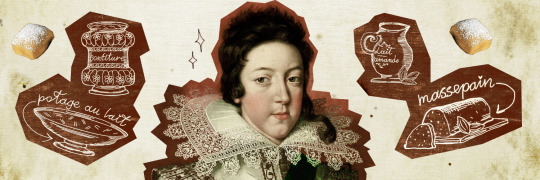
So, among 17th century royal sw- *ahem* DESSERTS we had in our menu – a jam, quince jelly, beignets (basically french donuts) and marzipans. In a well-known, among many of y'all Louis stalkers, journal of his doctor Jean Héroard I found some clear evidence of Louis XIII cooking some of these himself, so here it is feat. me periodically panicking over my own translation because my half-french friend is too busy atm and I don’t wanna bother them:
June 6th, 1611 — «He walks through the corridor from the study to the paneled gallery where he had an oven for making jams, he is amused to see how it's done.» I know it's not exactly him cooking, but I just wanted to leave it here :")
October 15th, 1612 — «Madame comes to see him; he has fun making jam with Mademoiselle de Vendôme»
January 29th, 1613 — «He often has fun making almond milk and marzipans at Madame's house.»
March 6th, 1615 — «It was very cold; he goes to the kitchen, makes omelettes, beignets, fried eggs; it was he who made them and ate a little of that he tasted.» Pretty sure the last few words could be translated better because it's always rather my terrible french or a little confusing way of Héroard's writing, so feel free to correct me.
February 3rd, 1616 — «He is preparing a small snack of dry jam for the queen, who must come to him at two o'clock. After going back to bed, he happily forms various battalions of his little silver men.»
February 5th, 1622 — «He leaves Saint-Germain, goes to Pontoise, where he enjoys making and eating beignets; while dining at Cormeille, he suddenly goes to the goblet in which he makes little cream puffs.» The original text says «petits choux au lait» and I have no idea what could that exactly be, but it seems like some sort of little éclair-like buns made of milk? Little cream puffs?? Maybe by «choux au lait» Jean meant «choux à la crème» which were invented back in 1540 in France.
I know you've been waiting for the quince jelly too, but unfortunately I couldn't find anything about the jelly :c Though, judging by what we've got here It's still quite possible Louis could cook quince jelly as well, hmm... Anyways, if you know something I don't know of the jelly mystery, hit me up!
In the future, this great love for desserts will be inherited by his son Philippe I, Duke of Orléans (brother of Louis XIV), who is also a very interesting character in history!!
In conclusion I must say that Louis not only had a sweet tooth, but also a big love for trying out different things, all this curiosity and pure excitement, even when it comes to something so simple and familiar like food, will never ever stop to fascinate me :"D
Btw speaking about Louis 'trying out different things', I of course still have a lot to share on this as well! Stay tuned and have a good day/night 💘💘💘
#I can't believe I wasted more time on the picture than the post itself#But at least now I can go make more Louis content :“”D#In my next post I will most likely cover something that is not food because he had A LOT of other talents obviously hahahaah#Honestly I could talk about him 24/7.... I just can't always be online to flood you with all this :“(#17th century#louis xiii#history of food#louis xiii le juste#king louis xiii
40 notes
·
View notes
Text

A Regimental Sergeant Major of the 11th Battalion, Royal Scots, hands out Mills bombs to a raiding party at Meteren. This raid was abandoned just when the party was ready to start because the leader was killed. Photograph taken on 12 July 1918.
#the great war#historical photos#world war one#world war 1#the first world war#1917#canadian history#ww1#wwi#history#ww1 history#ww1 poetry#ww1 fiction#british army#ww1 art#military history
90 notes
·
View notes
Text
The arrival of the XI International Brigade in Madrid
The XI Brigade finished their very rushed training the 3rd of November. It was composed of three batallions: Edgar André (Austro-German), Paris Commune (Franco-Belgian), and Dombrowski (Polish-Balkan), under the command of general Kléber, a Ukranian Jew member of Soviet military intelligence, real name Manfred Stern. The three batallions in turn were led by Hans Kahle, Jules Dumont, and Boleslav Ulanovski, respectively. That very same day, president of the Republic Largo Caballero gave the order to the XI Brigade to go to Madrid. In the night from the 4th to the 5th, went by train from Albacete to Alcázar de San Juan, and from there were shuttled by truck to the towns of Vallecas and Vicálvaro, where they were posted for three days. Even there, to the west of Madrid, they experienced the bombs and planes of the fascistic side, they were looming over Madrid.
The 7th of November, as they had feared, general Valeria had launched an assault on Madrid with 5 columns. 2 advanced on the southern bridges, while the other 3 attempted to take the open spaces around Casa de Campo in the east, take the French Bridge and access Madrid through the new university campus, and the neighborhoods of Argüelles and Cuatro Caminos. That very same day, what came to be known as the miracle of the Defense of Madrid started.
1,900 international volunteers traveled from Vallecas to Atocha Station, in Madrid's southwest edge. When they took formation in the station's esplanade, they did not know the results of the previous day's fighting, not even if the city had already been accessed. While they had a warm coffee and it rained lightly but coldly, they were able to see Stalin's portrait hanging on the National Hotel's facade. After a rally by Kléber, and the rain had stopped, they began their march towards the northeast. As they marched through the streets, some people warned them not to slip on the wet streets. It was early in a Sunday morning, but as it moved to midday, more people began to populate the streets, and cheers began to be heard from windows. From Atocha, they marched through the Paseo del Prado to Cibeles fountain, they turned into Gran Vía up to Telefónica's building. From here, all foreign correspondents would transmit their reports, and its height served as an advantageous position to spot for the artillery. It also received numerous strikes from the fascist artillery.
Along the Gran Vía, New Zealander correspondent for the London Chronicle, Geoffrey Cox, heard shouts "Long live the Russians!". He saw women with teary cheeks from emotion, one of them raised her small daughter, who raised her fist. The Yugoslav Veljko Ribar (Karl Anger) would note "Those old ladies with closed fists filled us with bravery and determination". Cox, who heard orders being shouted in French, noticed they were not Russians.
Once at the city's east, the battalions distributed themselves as follows: The Paris Commune Battalion defended the sector between the San Fernando Bridge and the Faculty of Philosophy; the Dombrowski Battalion was in the center, between the Faculties of Philosophy and Medicine; the Edgar André defended the front between the Model Jail and Cisneros roundabout, with their main focus being the French Bridge and the East Park. The 11th of November, according to the diary of Kléber's helper, Gustavo Durán, the fascist artilleray began to batter their positions at 12:20 with 10'5" and 15'5" shells.
The official report for the night of the 8th says: "The columns that defend Madrid in the south and southwest have suffered a terrible attack, carried out by effective forces with air support and tanks. Our forces have valiantly weathered the clash, maintaining their positions along the entire front. At midday, the Republican troops made a counterattack, taking new positions and capturing a tank along with its occupants. Morale is excellent, and today has been a harsh trial, the enemy has ended it gravely broken". The arrival of the XI Brigade fortified this morale, and in the 9th it had to defend against the first charge: Valera's forces crossed the Manzanares river through the French bridge and made it all the way to the Model Jail (today the headquarters of the Air Force). Heavy fighting ensued, in which both Spanish and International forces participated, but by next morning, the remaining assailants were forced to retreat back across the river.
Translated, adapted, and expanded from the first volume of International Brigades' Sites in the Center of Madrid, Vol. 1, published by the Association of the International Brigades' Friends
14 notes
·
View notes
Text

U.S. Army paratroopers from 3rd Battalion, 509th Parachute Infantry Regiment, 11th Airborne Division, jump from C-17 onto Donnelly Training Area, Alaska. 8 Feb 2024
40 notes
·
View notes